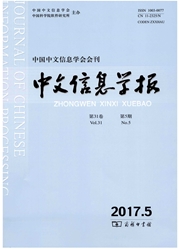

 中文摘要:
中文摘要:
交集型歧义的切分问题是分词阶段需要解决难点之一。该文将交集型歧义的消解问题转化为分类问题,并利用融合丰富字特征的最大熵模型解决该问题,为了克服最大熵建模时的数据稀疏问题,该文引入了不等式平滑技术和高斯平滑技术。我们在第二届国际分词竞赛的四个数据集上比较了高斯平滑技术、不等式平滑技术和频度折扣平滑技术,测试结果表明:不等式平滑技术和高斯平滑技术比频度折扣技术有显著提高,而它们之间不分伯仲,但是不等式平滑技术能使特征选择无缝嵌入到参数估计过程中,显著压缩模型规模。该方法在四个测试集上最终获得了96.27%、96.83%、96.56%、96.52%的消歧正确率,对比实验表明:丰富的特征使消歧性能分别提高了5.87%、5.64%、5.00%、5.00%,平滑技术使消歧性能分别提高了0.99%、0.93%、1.02%、1.37%,不等式平滑使分类模型分别压缩了38.7、19.9、44.6、9.7。
 英文摘要:
英文摘要:
The overlapping ambiguity strings(OAS) is one of the difficulties in automatic Chinese word segmentation.This paper treats the resolution of OAS asa classification task,using maximum entropy integrating character features to solve the problem.In order to overcome the data sparseness in maximum entropy modeling,this paper introduces the inequality smoothing techniques and Gaussian smoothing techniques.We compared the Gaussian smoothing,inequality smoothing and frequency discount on the four datasets of the Second International Chinese Word Segmentation,proving that Gaussian smoothing,inequality smoothing are much better than the discount method..while inequality smoothing enables the seamless integration of feature selectioninto the parameter estimation with the result of a significantly compressed model.On the four datasets,the precision of disambiguation by the proposed method can achieve 96.27%,96.83%,96.56%,96.52% respectively,with a relative improvement of 5.87%,5.64%,5.00%,5.00% by the rich feature and a relative improvement of 5.87%,5.64%,5.00%,5.00% by smoothing technology.Meanwhile,the classification models are compressed by 38.7,19.9,44.6,9.7 by using inequality smoothing.
 同期刊论文项目
同期刊论文项目
 同项目期刊论文
同项目期刊论文
 Web-oriented OOV translation extracting approach through cross-language query expansion for English-
Web-oriented OOV translation extracting approach through cross-language query expansion for English- BioPPISVMExtractor:A Protein-Protein Interaction Extractor for Biomedical Literature Using SVM and R
BioPPISVMExtractor:A Protein-Protein Interaction Extractor for Biomedical Literature Using SVM and R Uncertainty sampling-based active learning for protein-protein interaction extraction from biomedica
Uncertainty sampling-based active learning for protein-protein interaction extraction from biomedica Improving the performance of bio-entity name recognition in biomedical literature via the contextual
Improving the performance of bio-entity name recognition in biomedical literature via the contextual Incorporating rich features to boost information retrieval performance: A SVM-regression based re-ra
Incorporating rich features to boost information retrieval performance: A SVM-regression based re-ra 期刊信息
期刊信息
